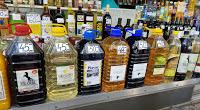
St. Donat Kopaszhegy
Olaszrizling 2018

Grasevina in a market in Split
In many cases, particularly in Croatia and Hungary, the wines are rather pedestrian, light and neutral, where they are favored in boxes or jug or as the base for the Hungarian wine spritzer: fröccs. However, in a particular microclimate with volcanic soils or in specific environments these wines find a more complex expression. In the latter case, the grapes form noble rot botrytis among the humid vineyards surrounding Lake Neusiedl Austria leading to more depth and fullness. And in the stratovolcanic chain within the cooler continental climate in Slavonia, Croatia or the volcanic basalt soils of Somló and Lake Balaton Hungary, the wines show even greater depth.In the specific case surrounding Lake Balaton, Olaszrizling wines generally show complex minerality as they receive a boost of minerality and saltiness due to the basalt bedrock which releases minerals such as potassium, magnesium, and calcium into the soils. These wines also provide a roundness that balances the grape's inherent acidity.
One such example is the St. Donat Kopaszhegy Olaszrizling 2018 ($21) available in the U.S. via Taste Hungary. This wine comes from a single vineyard Kopaszhegy (Bald Hill) on the Tihany peninsula in the Balatonfüred-Csopak wine region located on the northeastern shore of Lake Balaton (the largest lake in central Europe). And in this region, the wines are traditionally sold using the name of the hill, with each having its own character. This wine is fermented spontaneously without inoculating with yeast and bottled naturally without clarifying and filtering. It starts with a brief, initial impression of neutrality only because the sense of fruit is outweighed by a hefty dose of minerality that is sustained throughout. The wine also provides roundness and depth that blends with the fresh acids - too complex to be used in fröccs.
